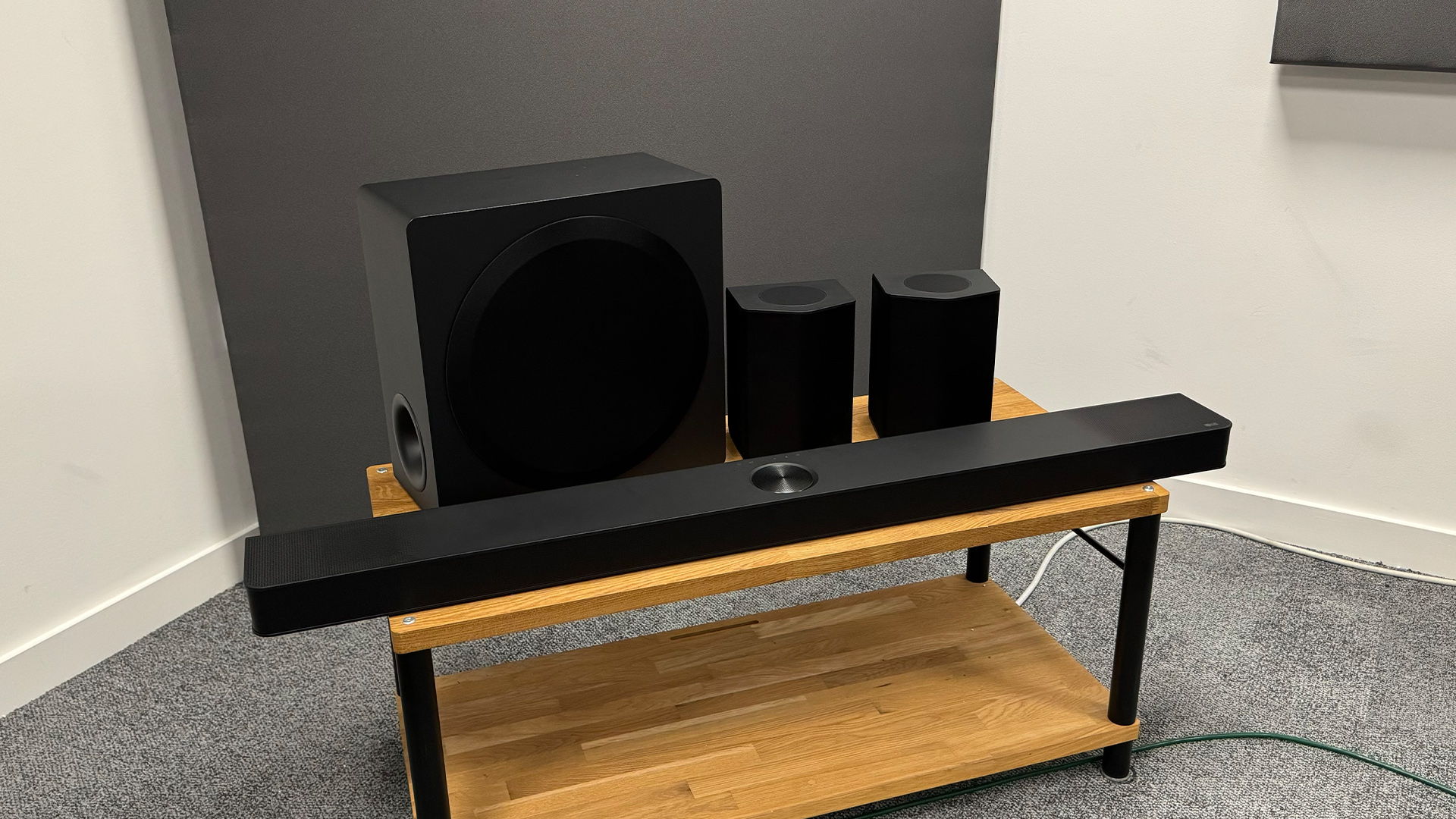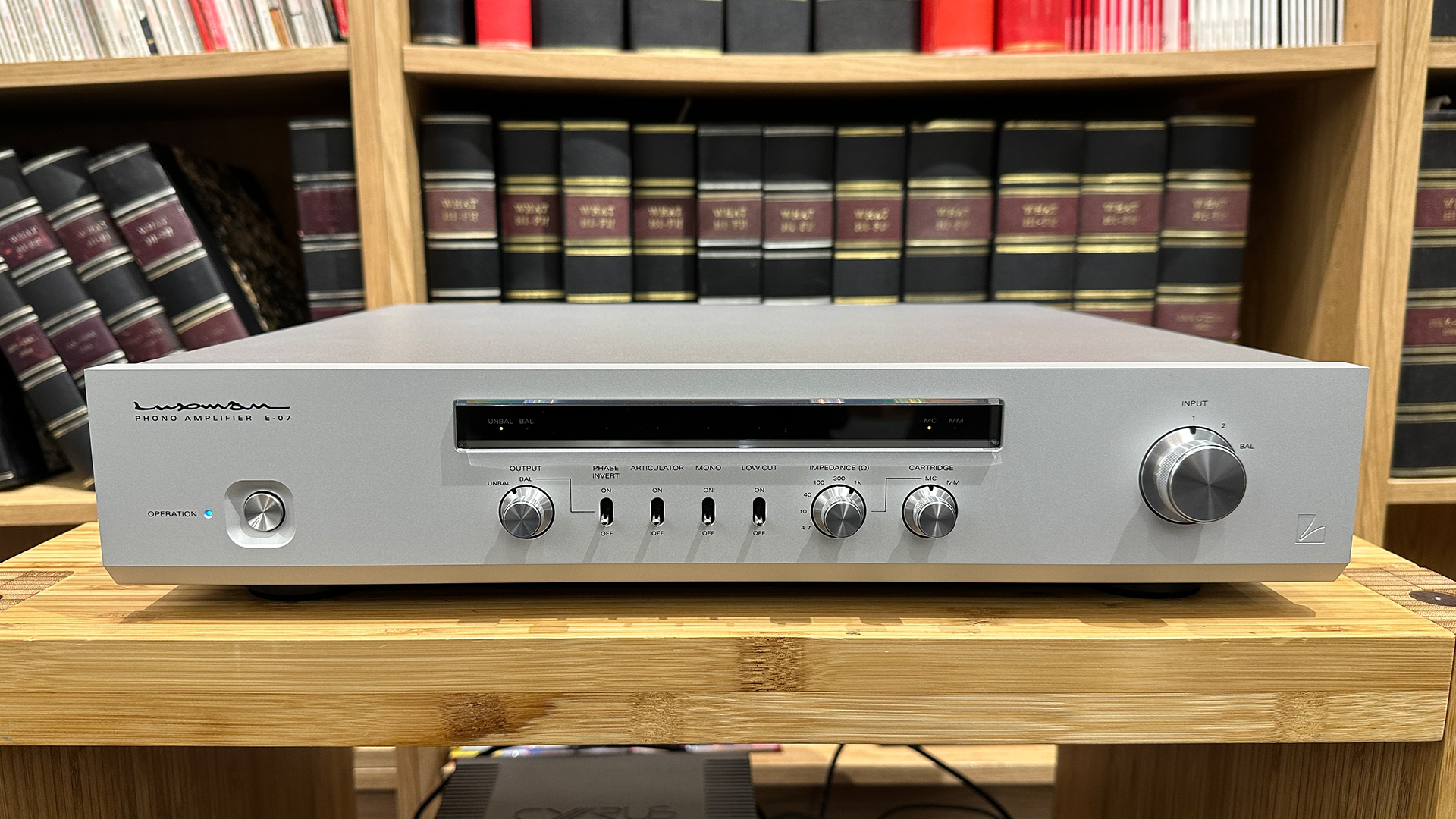What Hi-Fi? Verdict
The LG S95TR isn’t bad in isolation, but it lacks some finesse and lags behind the best in class, particularly when it comes to 3D sound
Pros
- +
Reasonably punchy and detailed sound
- +
Very open and spacious
- +
HDMI 2.1 passthrough
Cons
- -
Tonal inconsistencies between ’bar and surrounds
- -
Lack of three-dimensionality to sound
- -
Occasionally overbearing and waffly bass
Why you can trust What Hi-Fi?
The soundbar speaker system is an increasingly popular product type. And with good reason, too: when done right, a package consisting of a soundbar, two wireless surround speakers and a wireless subwoofer can get surprisingly close to delivering the core experience of an AV receiver and 15 individual speakers. Little wonder that’s so appealing to so many people.
LG’s 2024 take on the concept is the S95TR, which is invariably and irritatingly also referred to by LG as the US95TR and US95T in the UK. Conceptually and financially it’s very similar to the Samsung HW-Q990D, which now looms large over this category. Can the LG compete? You’ve presumably seen the star rating above and know that it can’t…
Price
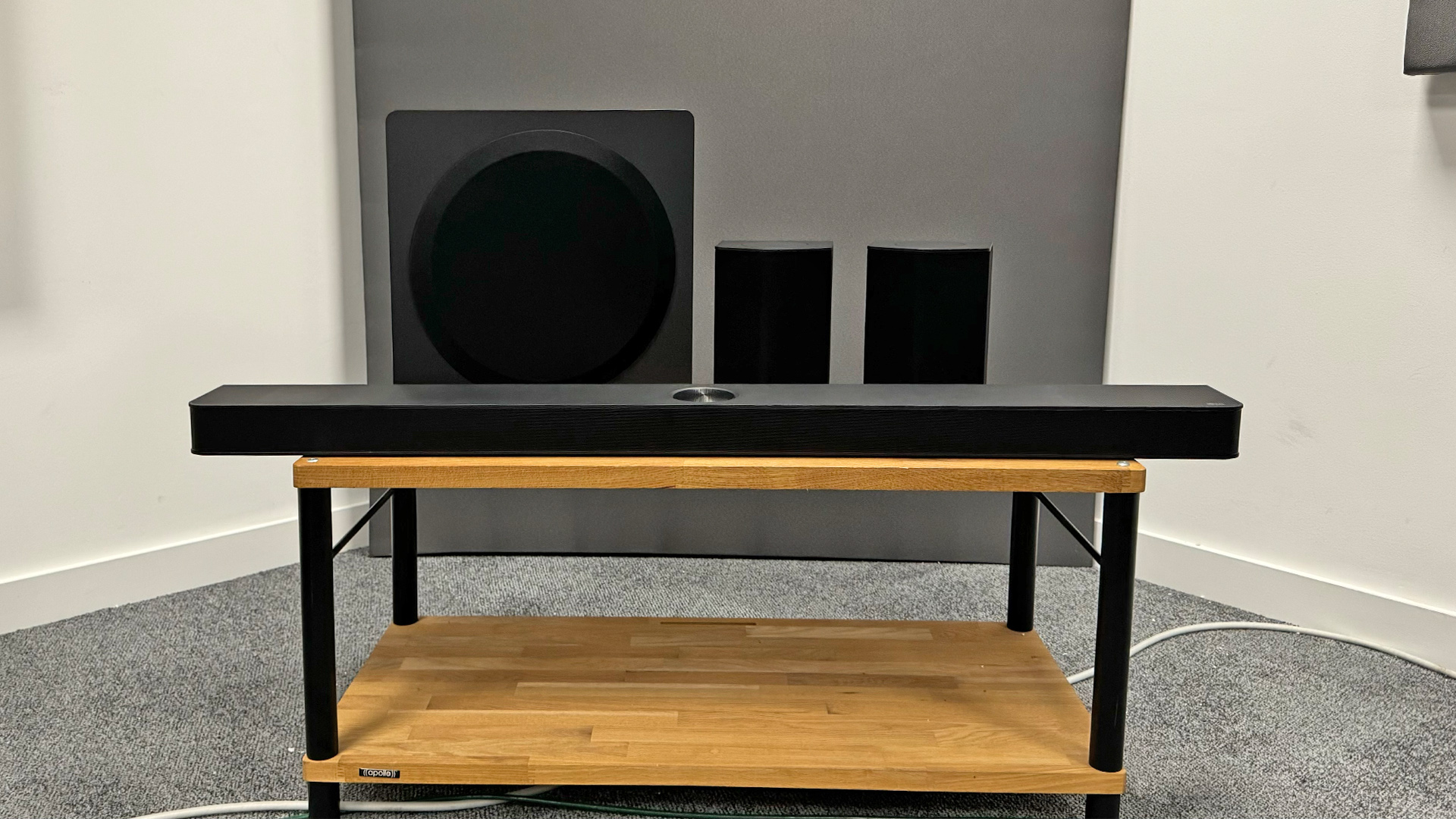
The LG S95TR’s launch price is £1699 / $1500 / AU$1699 which, in the UK at least, is eerily similar to how much the Samsung Q990D was at launch, and we expect the two products to compete closely on price over the course of the year.
As with the Samsung, that makes the LG a decidedly premium proposition, but it’s worth considering that an equivalent Sonos set-up consisting of an Arc, Sub and two Era 300 speakers (the so-called Ultimate Immersive Setup with Arc) would currently set you back £2336 / $2346 / AU$4081. Sony’s new flagship soundbar meanwhile, the Bravia Theatre Bar 9, is £1399 / $1400 / AU$1799 for the ’bar alone. Add the optional surrounds and/or subwoofer and the price will roughly double.
Design
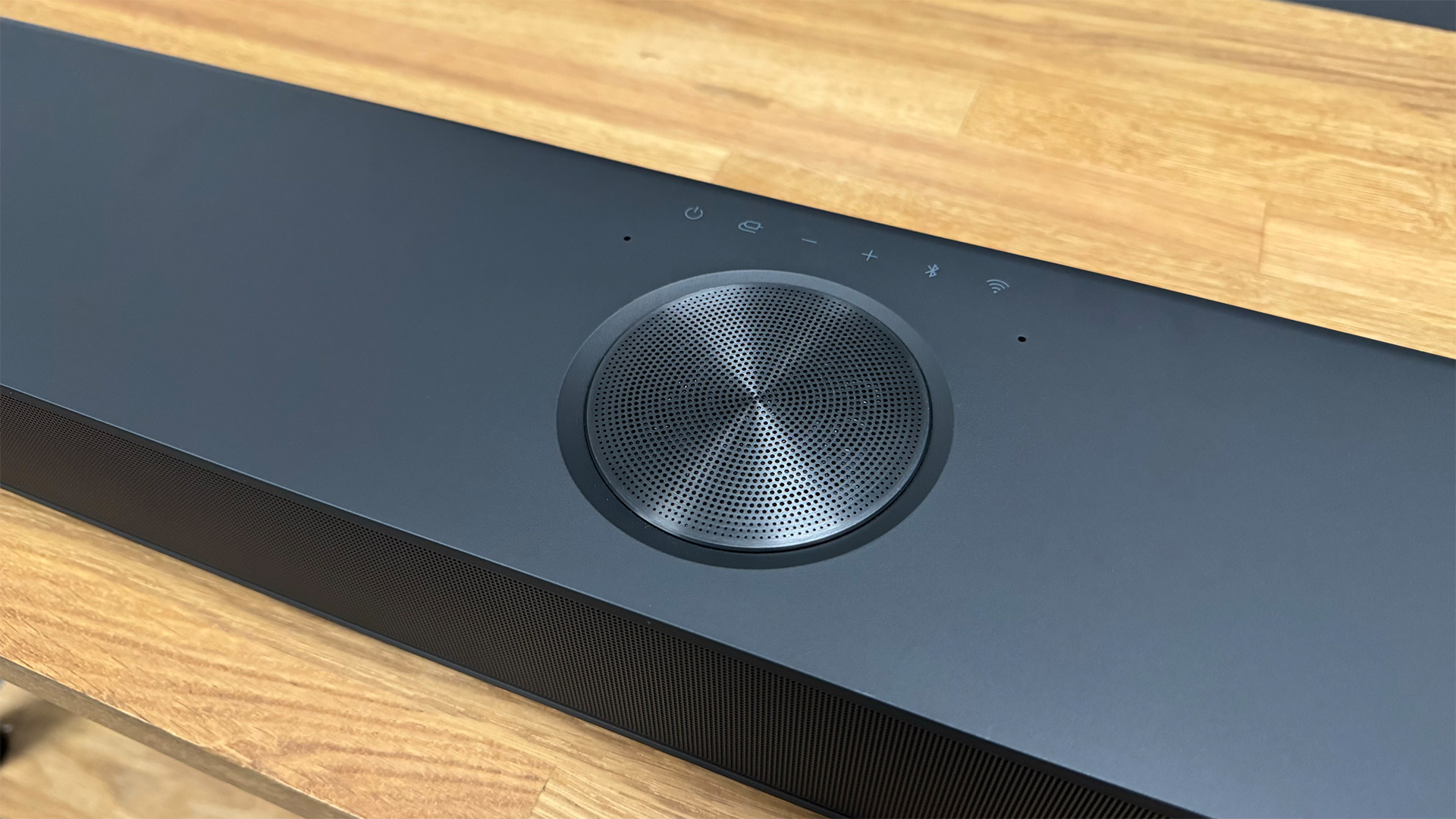
As mentioned, the LG S95TR consists of a soundbar, two wireless surrounds and a wireless subwoofer. While the main soundbar itself is dimensionally very similar to that of the Samsung Q990D package, it somehow looks more svelte. We think that might be down to the more rounded corners and edges. The height of 63 mm means the soundbar will sit in front of most modern TVs without obscuring the bottom of the screen, but the width of 125cm might be an issue for some TV stands. As ever with Dolby Atmos soundbars, the S95TR needs clear air above it in order to work correctly, so don’t park it in a unit with a shelf above.
Unfortunately, there’s no display on the soundbar – not even a basic dot matrix one like that featured on the Samsung Q990D. You can only figure out what the soundbar is doing by either interpreting the pattern and colour of the three LEDs on the front, opening the smartphone app or pressing a button on the remote so that you get a spoken response from the soundbar, none of which feels like a particularly satisfying alternative to a simple display.
The two wireless surrounds are a bit chunky and angular, but a bracket is included in the box for relatively simple wall-mounting. Again, you don’t want to put these in a little cubby hole as they need space above and to the sides in order to spread their sound around. It's worth noting that the power cables for the wireless speakers aren't particularly long (those supplied with the Samsung Q990D are much longer). While you can buy replacements, the originals have an awkward right-angle design that any alternative cable needs to replicate.
The latest hi-fi, home cinema and tech news, reviews, buying advice and deals, direct to your inbox.
The wireless subwoofer, finally, is a fairly nondescript big, black block that is best positioned relatively close to the soundbar for best performance.
Features

The most unusual feature of the LG S95TR is its central up-firing speaker, which LG says is for "making voices clearer and on-screen action perfectly synced with the audio". This is joined by four further up-firing speakers – two more on the ’bar and one on each of the wireless surrounds – to contribute the '.5' in the system's total 9.1.5-channel configuration.
The S95TR uses its array of channels to deliver Dolby Atmos and DTS:X sound, as well as what LG refers to as 'Triple Level Spatial Sound' which, the company claims, "adds a virtual layer to create a sound dome around you of richer sound". This is only in effect when using the Cinema or AI Sound Pro modes – more on which in the sound section.

Connectivity HDMI out (eARC), 1 x HDMI 2.1 in, optical, wi-fi, Bluetooth, Chromecast, AirPlay 2
Format support Dolby Digital, Dolby Atmos, DTS Surround, DTS:X
Streaming Spotify Connect, Tidal Connect
Voice control Amazon Alexa
Soundbar dimensions (hwd) 6.3 x 125 x 14 cm
Soundbar weight 5.7kg
Surround speaker dimensions (hwd) 22 x 16 x 14 cm
Surround speaker weight 4kg
Subwoofer dimensions (hwd) 41 x 20 x 40 cm
Subwoofer weight 10kg
As has become the norm for brands that produce both soundbars and TVs, the S95TR has a number of features that are enabled if it’s connected to a new or recent LG TV. Those features are WOWCAST, which allows for a wireless connection between the soundbar and TV; WOW Interface, which integrates many of the soundbar’s controls into the TV’s menus, somewhat overcoming the issue of there being no display on the soundbar itself; and WOW Orchestra, which combines the soundbar’s speakers with those of the TV.
As with every other soundbar at this level, the S95TR is designed to connect to your TV via HDMI eARC, but it also has a dedicated HDMI input and the soundbar is able to pass through video in 4K and HDR, with 120Hz, VRR and ALLM all supported. That will be music to the ears of gamers – particularly those who own a TV with limited HDMI 2.1 sockets. It’s worth noting that the Sonos Arc doesn’t have a dedicated HDMI input. The Samsung Q990D, though, has two.
Of course, HDMI isn’t the only way to send sound to the S95TR, which also supports Spotify Connect, Tidal Connect, Google Cast and AirPlay 2. The wi-fi connection also allows for control via the LG Soundbar app. Calibration is handled here, too, and is very quick, but it’s worth mentioning that the calibration of the Samsung Q990D is done automatically, with no user intervention required.
Sound
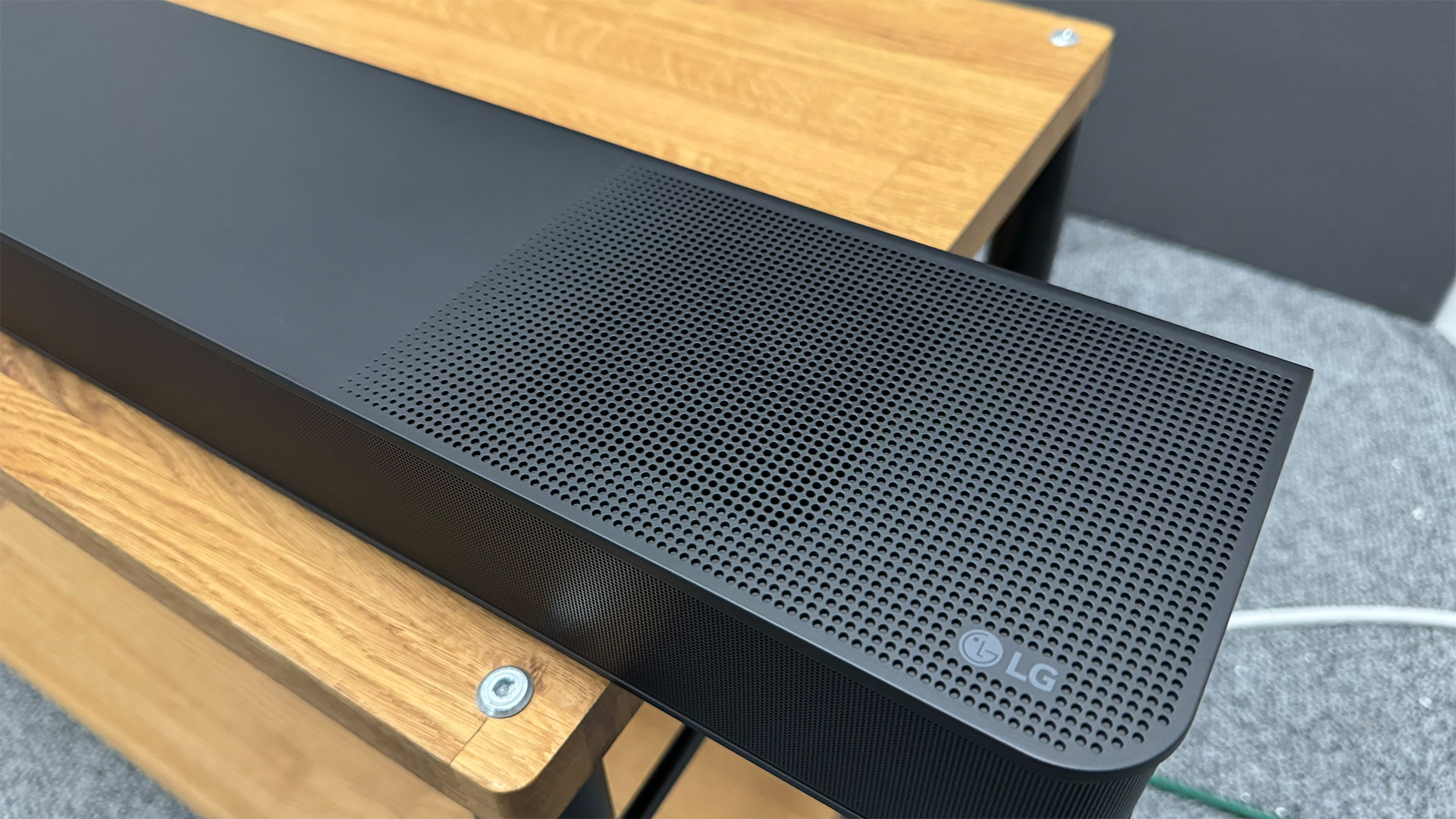
We often begin our soundbar testing with music, not because we think this is what an owner will use it for most, but because it often provides a really good indication of its core sonic strengths and weaknesses. So, after a couple of days of running in, we send Tool’s Invincible (in 24-bit/96kHz hi-res, no less) to the S95TR via Tidal Connect. Unfortunately, the LG soundbar makes a dreadful first impression, primarily by defaulting to the AI Sound Pro setting, which up-mixes the stereo signal and sends it out to all channels. This sort of up-mixing isn’t uncommon and it isn’t always bad, but the implementation here is really quite unpleasant, adding a weird echo to Maynard James Keenan’s vocals and making the guitars sound very harsh. The processing doesn’t seem to know which sounds should be handled by which speakers, either, and elements move around the soundstage in a disorienting fashion.
Thankfully, you don’t have to stay in the AI Sound Pro mode, and we highly recommend that you don’t. However, only two of the LG’s sound presets disable the up-mixing, those being Standard and Music. Of those, it’s Standard that we prefer. The two modes aren’t vastly dissimilar and both play stereo as stereo, but Music makes the bass more boomy and overbearing and it makes vocals less clear and distinct from the rest of the midrange. Everything is much tighter and better balanced in Standard.
Now, the track sounds much better. Keenan’s voice is clear and fairly emotive, the drums and bass are pretty precise and tuneful, and there’s plenty of space afforded to each element. There’s not a great deal of dynamic range on show, but there’s just about enough punch and spaciousness to the delivery to ensure there’s still a clear element of progression to the track. Some extra detail and richness would be appreciated, particularly in the vocals, but there’s at least no longer any harshness to the delivery.
After listening to several more music tracks of various qualities, all of which back up our experience with Invincible, we move on to the meat of our testing – movies. We again have to make a decision about which preset to use, with AI Sound Pro, Cinema and Standard the appropriate options for movie content. You might expect AI Sound Pro, which is designed to identify the type of content being played and adapt the sound profile accordingly, to sound the same as Cinema when watching a movie, but it doesn’t, and our lack of faith in the setting’s intelligence prompts us to move off it pretty quickly.
It’s a much tougher call between Cinema and Standard. Cinema makes everything boomier and more bombastic, which in some ways is quite enjoyable, but it also makes the sound less clean and precise and the bass more rumbly and overbearing. Cinema also projects dialogue more, which is a good thing for clarity but at times seems a bit forced and unnatural.
One supposed benefit of Cinema is that it’s in this mode (as well as AI Sound Pro) that the 'Triple Level Spatial Sound' is enabled, which is intended to create a dome of sound with more height. However, we don’t find the effect to be very pronounced, and whether we choose Cinema or Standard, the sound predominantly inhabits a horizontal plane at about ear height. It isn’t that the S95TR never sends sound over the listening position, but it does so less frequently and less convincingly than the admittedly exceptional-for-a-soundbar Samsung Q990D. In short, this Triple Level Spatial Sound isn’t a terribly convincing reason to choose Cinema over Standard.
In Standard, voices are less isolated and projected than they are in Cinema, which can make them a little less clear, but the delivery is much more unified and cohesive overall. It sounds more natural and balanced, and the subwoofer (which, as we’ll get to, is a real weak point of the system) is much better behaved. It’s for these reasons that we feel Standard is the better choice overall, though it’s clear that there is no best-of-all-worlds setting with the S95TR, so you should experiment yourself and go with your personal preference.
Having finally settled on our preferred sound setting, we start working through our favourite Dolby Atmos test discs, starting with Unbroken. The S95TR does a reasonable job with this overall. There’s enough detail and dynamic variance to audibly convey the very different environments of the different positions on the Liberator aircraft, there’s a really spacious and open quality to the soundstage that’s quite immersive, and while voices aren’t as clearly projected as they would be in the Cinema mode, they sound natural and fairly textured.
There are issues, though. As mentioned, the S95TR doesn’t do a great job of delivering the verticality of the scene, and there’s also a bit of a tonal mismatch between the soundbar and the surrounds that means we’re often made distractingly aware of some effects, most obviously the Japanese fighter planes as they swoop from the front to the back of the room. There’s not a great deal of three-dimensionality to the presentation either: sounds move around all four edges of the room but there’s not much sense of some being closer and others further away.
The subwoofer, meanwhile, really isn’t up to the standard set by rivals. The distant, heavy rumble of the Liberator’s bombs hitting the target produces some nasty, waffly chuffing from the bass driver, even in the Standard mode – and it’s worse in Cinema and AI Sound Pro. Interestingly, this chuffing isn’t evident when we switch to our usual bass stress test – the DTS:X-soundtracked Blade Runner 2049 – but neither is there much tonality or control. It just sounds rather boomy and overbearing.
Sticking with Blade Runner 2049, as K crosses the street to his apartment building, the sounds of the traffic and holographic billboards fills the room, but our ears are drawn a little too often to specific speakers rather than specific sound effects and their positions in three-dimensional space.
Verdict

It might read as if the LG S95TR is a disaster, but that isn’t the case. Use it in isolation and find the right audio preset and it will deliver a broadly satisfying movie experience that will surround you and provide some of the height generally associated with Dolby Atmos. It’s punchy enough to make an action scene exciting and a music track engaging, and there’s lots of bass.
There are some issues that you will be made aware of even in isolation, most obviously the sometimes overbearing and occasionally waffly subwoofer, but the bigger issue for this LG ’bar is the quality of its competition.
The Samsung HW-Q990D is a big step forward for the category. It’s more detailed, direct and dynamically capable, both in terms of big shifts and subtle variations. More importantly, though, it delivers a seamless, room-filling sound into which it places effects in a way akin to an AV receiver and Atmos speaker package. The LG S95TR isn’t bad, but it’s a fair way short of that level.
SCORES
- Sound 3
- Build 4
- Features 4
MORE:
Read our review of the Samsung HW-Q990D
Also consider the Samsung HW-Q990C
Read our Sony Bravia Theatre Quad review
Best soundbars: options for every need, recommended by our experts
What Hi-Fi?, founded in 1976, is the world's leading independent guide to buying and owning hi-fi and home entertainment products. Our comprehensive tests help you buy the very best for your money, with our advice sections giving you step-by-step information on how to get even more from your music and movies. Everything is tested by our dedicated team of in-house reviewers in our custom-built test rooms in London, Reading and Bath. Our coveted five-star rating and Awards are recognised all over the world as the ultimate seal of approval, so you can buy with absolute confidence.
